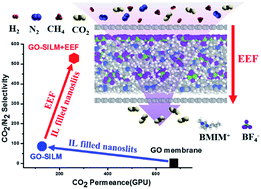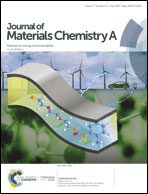Selectively tuning gas transport through ionic liquid filled graphene oxide nanoslits using an electric field†
Abstract
Hybrid membranes with nanoconfined ionic liquid (IL) have demonstrated promising potential for CO2 separation, while the trade-off between their permeance and selectivity is still an obstacle. In this work, an IL is confined in the 2D nanochannels (nanoslits) between graphene oxide (GO) nanosheets to form a GO-supported IL membrane (GO-SILM). By applying an external electric field (EEF), the separation performance is significantly elevated, doubling the CO2 permeance to 260 GPU and enhancing the selectivity of CO2/H2, CO2/CH4, and CO2/N2 up to 43, 262, and 529, respectively, remarkably higher than that of a GO-SILM without an EEF. The performance is superior to the upper bound of state-of-the-art membranes. Molecular dynamics simulations show that the breakthrough comes from EEF-induced redistribution of cations and anions of the IL in the GO nanoslits, and thus changes the adsorption/desorption free energy, free volume and interaction energy of the IL. It has tapped the potential of the IL to its best. The synergistic effect of solubility and diffusivity of CO2 results in asymmetric CO2 permeance under positive and negative EEFs. These findings may open up an avenue for the design of advanced membranes for gas separation.



 Please wait while we load your content...
Please wait while we load your content...